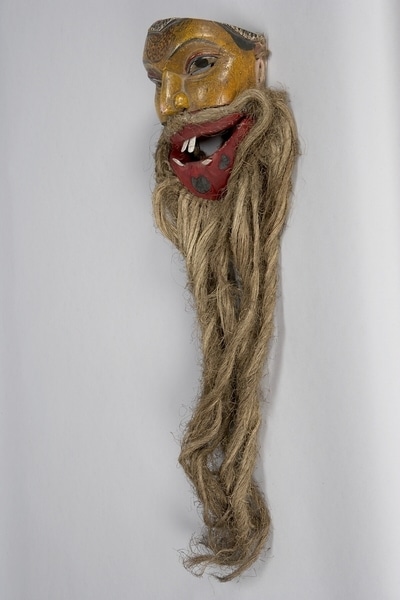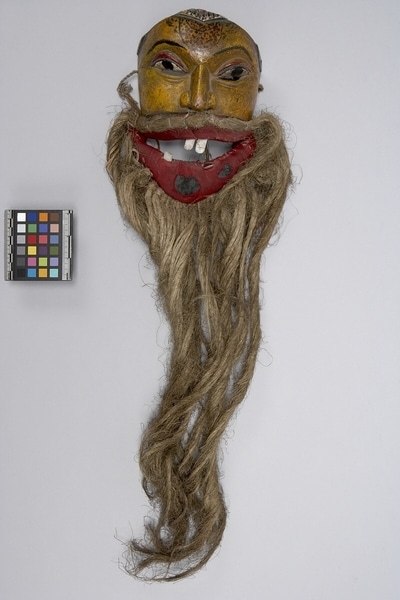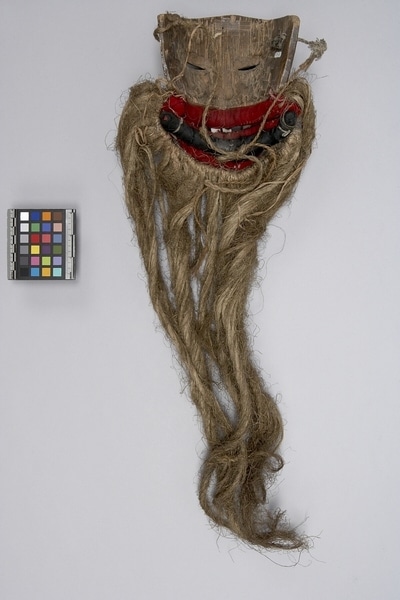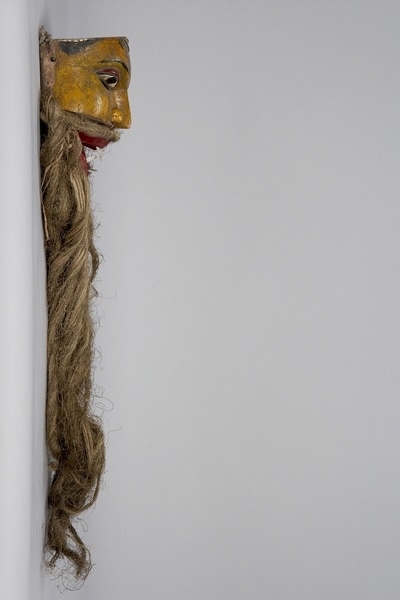Mask Item Number: Eh18 from the MOA: University of British Columbia




Description
Mask with dark yellow face decorated with low relief triangles painted in black, white and red, and a U-shaped area in the middle of the forehead filled in with dots in red and black. The mask also has black eyebrows, red upper eyelids, eyes that look downwards and each have a crescent-shaped slit underneath, a pointed nose with nostril holes, and plant fibre twine straps. The upper and lower jaw are hinged with thread and are made from wire covered in red fabric. Two teeth protrude from the centre of the top lip, and two teeth on the bottom lip sit either side of the top teeth. The moustache and beard are of hemp, fastened to the mask with thread.
History Of Use
The Kolam is a secular entertainment with considerable elements of social satire. It incorporates narrative, mime, dance, and music. A Kolam performance usually has four episodes the precise content of which may vary. These consist of a prelude, detailing the origin of the drama; the arrival of a royal party and dances by characters mythical, human and animal; enactment of a popular story or stories; and a purifying demon dance. This mask may be the Kolam drummer, Panikkale, used as King Sakara in the Amba-Vidamana episode of the Devolmaduva or Gammaduva ceremonies. In this episode, Sakara comes in the guise of an old man to shoot down a strange mango in the garden of the king of Pandi. These ceremonies are household and village protection rituals.
Cultural Context
exorcism
Iconographic Meaning
The yellow skin colour signifies a benevolent demon in Buddhist mythology. Yellow shades are also used for high officials and royalty.
Item History
- Made in Sri Lanka before 1978
- Collected during 1978
- Owned by Jason Schoonover before February 10, 1981
- Received from Museum of Anthropology Shop Volunteers (Funding source) and Jason Schoonover (Seller) on February 10, 1981
What
- Name
- Mask
- Identification Number
- Eh18
- Type of Item
- mask
- Material
- nux vomica wood ?, plastic, cotton fibre and hemp fibre
- Manufacturing Technique
- carved, knotted and painted
- Overall
- height 63.0 cm, width 21.0 cm, depth 11.0 cm
Who
- Culture
- Sinhalese
- Previous Owner
- Jason Schoonover
- Received from
- Museum of Anthropology Shop Volunteers (Funding source) and Jason Schoonover (Seller)
Where
- Holding Institution
- MOA: University of British Columbia
- Made in
- Sri Lanka
When
- Creation Date
- before 1978
- Collection Date
- during 1978
- Ownership Date
- before February 10, 1981
- Acquisition Date
- on February 10, 1981
Other
- Condition
- fair
- Accession Number
- 0704/0017